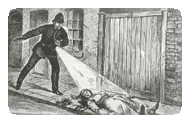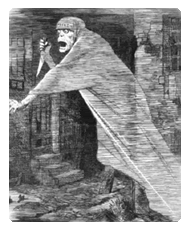Thursday, March 27, 2008
Crippen Innocent?
A researcher thinks he can prove Dr. Crippen was innocent of killing his wife. From Channel 8 in Grand Rapids, Michigan:
Jack's Number One! Jack's Number One! Jack--sorry.
It isn't "walking" away, but he did leave her behind, like a poisoner would. Palmer did; Cream did; Shipman did. But I agree--the mutilation is odd, but still understandable.
The reasons for that? Overwhelming circumstantial evidence tying him to the crime, the proximity of the body, the relationship between the Crippens, his affair, his knowledge of poisons and "elixirs," his opportunity, his desire to leave his wife, his leaving the country right after talking to the police, the testimony of Bernard Spilsbury--how much time do you need to convict?
Exactly.
You have got to be kidding.
Um, even IF he's exonerated (a HUGE "if," colossal, grand even), there was A BODY BURIED UNDERNEATH HIS HOUSE WHICH HE APPARENTLY KNEW ABOUT, HAD ACCESS TO AND COVERED IN (what turned out to be the wrong kind of) LIME. I'd hold off on the cries of "innocent," if I were the family. Plus, why say his wife went to New York if he didn't kill her? He admitted he lied about that--it's not like proving the body in his house wasn't Belle would remove all suspicion from him for her disappearance. It's just as likely that he's responsible for two bodies. Not likely, just as likely as the scenario that he didn't kill his wife and the body underneath his house had nothing to do with him.
Exonerated after execution, 100 years later
By Jessica Leffler
COLDWATER, Mich (WOOD) -- DNA testing and science not available almost a hundred years ago is beginning to shed light on a case of a man tried and executed.
Hawley Crippen, originally from Coldwater, Mich., was hanged for the murder of his wife Cora Crippen in London in 1910.
Now, John Trestrail, a toxicologist from West Michigan, believes he might have exonerated Crippen.
"I often refer to this as the O.J. Simpson trial of the early 1900s," Trestrail said. "This is the second most famous murder case in London, exceeded only by Jack the Ripper."
Jack's Number One! Jack's Number One! Jack--sorry.
It was a sensational trial with convoluted twists.
Crippen's wife, Cora, was missing, and he was rushing across the Atlantic on a ship with his mistress.
Meanwhile, back in London, a dismembered body was discovered, buried beneath his house and believed to be Cora.
Crippen claimed the pair had a fight and she headed back home to the United States. However, the trial revealed gruesome details saying Crippen poisoned his wife, then mutilated her body, burying the remains with no head or bones.
Trestrail, who works in foresic toxicology, thought something just did not add up.
"The thing that kept me coming to the case was the dismemberment of his wife Cora," he said. "Because a poisoner is against what they normally do, poisoners are secret, visible killers. They like deaths to appear natural, then they walk away."
On their way to Canada, the captain of the ship told Scotland Yard he had Crippen and his mistress, Ethel La Neve, who was diguised as a boy aboard the ship.
It isn't "walking" away, but he did leave her behind, like a poisoner would. Palmer did; Cream did; Shipman did. But I agree--the mutilation is odd, but still understandable.
Detectives greeted them when their boat landed. La Neve was aquitted, but Crippen wasn't as lucky.
"The jury is out only 27 minutes," Trestrail said of the trial. "They come in and say 'Guilty.'"
The reasons for that? Overwhelming circumstantial evidence tying him to the crime, the proximity of the body, the relationship between the Crippens, his affair, his knowledge of poisons and "elixirs," his opportunity, his desire to leave his wife, his leaving the country right after talking to the police, the testimony of Bernard Spilsbury--how much time do you need to convict?
Throughout the trial, Crippen maintained his innocence.
Now, 100 years later, Trestrail is armed with information about Mitochondrial DNA, which can prove lineage from mother to daughter and is a genetic blue print.
Along with the help of a geneologist and a forensic biologist, the trio tracked down two half-grand nieces of Cora Crippen.
The family members matched one another. The original slides with the remains of the body from the trial did not.
"He called me and said it's done," Trestrail said. "I've done the test twice and got the same results both times. It's not her, and that kind of raised the hair on my arms because now there's more questions."
More questions than answers, like whose body was discovered under the home?
Exactly.
"He may have killed this person," Trestrail said. "Whoever it is, not (his wife Cora). But that's another trial."
You have got to be kidding.
And if the body wasn't his wife, where did she go? These questions may not be solved.
For 30 years, Trestrail has worked on this case, collecting antiquated newspapers or photographs, frozen into their yellowed pages as a glimpse into the past. A history he is hoping to help rewrite.
"Like I say, 40 books have been written on this case," he said. "I suppose I'll have to write number 41."
Trestrail was able to contact some distant relatives of Crippen who now live in Ohio. They want Crippen posthumously cleared of the crime.
Trestrail is now working on a documentary with a film team from London this week.
Um, even IF he's exonerated (a HUGE "if," colossal, grand even), there was A BODY BURIED UNDERNEATH HIS HOUSE WHICH HE APPARENTLY KNEW ABOUT, HAD ACCESS TO AND COVERED IN (what turned out to be the wrong kind of) LIME. I'd hold off on the cries of "innocent," if I were the family. Plus, why say his wife went to New York if he didn't kill her? He admitted he lied about that--it's not like proving the body in his house wasn't Belle would remove all suspicion from him for her disappearance. It's just as likely that he's responsible for two bodies. Not likely, just as likely as the scenario that he didn't kill his wife and the body underneath his house had nothing to do with him.
Labels: Dr. Crippen, Jack the Ripper, Jack the Ripper and Me
















